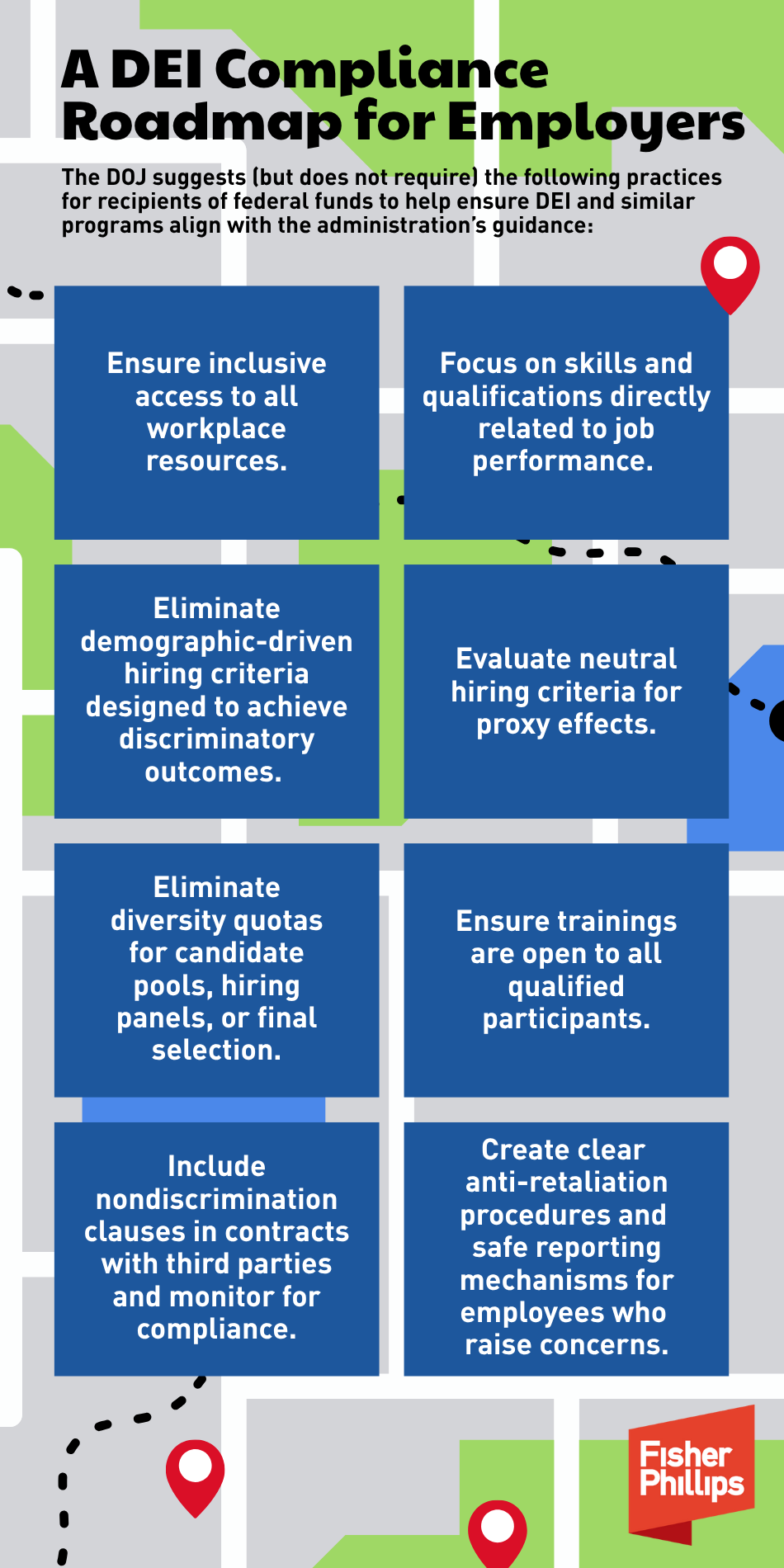New DEI Guidance Ties Federal Funding to Compliance and Provides Roadmap for Employers: Your 6 Biggest Takeaways
Insights
8.04.25
Federal officials just issued another warning that employers may be at risk of losing federal funding – including grant funding – if their DEI or similar programs violate anti-discrimination laws. Recent guidance from the Department of Justice (DOJ) signals that now is a good time to ensure your programs align with legal standards. The July 29 guidance reminds all federal agencies and recipients of federal funding that programs should not discriminate based on race, color, national origin, sex, religion, or other protected characteristics “no matter the program’s labels, objectives, or intentions.” The DOJ also suggested best practices for creating compliant programs. While these practices are not required, all organizations and HR departments can use the guidance as a roadmap. This is the latest in a string of directives from the Trump administration clarifying how the administration interprets existing federal civil rights laws to apply to diversity, equity, and inclusion programs. Here’s what you need to know.
6 Key Points for Employers
The purpose of the guidance, according to the DOJ, is to ensure “taxpayer money is used lawfully and for the public good” and the government is “serving the American people and not ideological agendas.” The memo identifies six key categories of discriminatory policies and practices that may run afoul of federal civil rights laws – including Title VII of the Civil Rights Act – and put funding in jeopardy:
1. Preferential Treatment
According to the guidance, organizations that receive federal funding may not provide opportunities, benefits, or advantages to individuals or groups based on protected traits – including race and sex – in a way that disadvantages other qualified people (except in very limited situations). Examples provided include race-based internships and preferential hiring or promotion decisions.
2. Creating New Criteria that are Merely Proxies
You should not use “ostensibly neutral criteria” that are simply substitutes for unlawful considerations based on race, ethnicity, sex, or other protected characteristics. Examples include asking about “cultural competence,” “lived experience,” or “cross-cultural skills” with the intention of making selection decisions based on race or ethnicity. The guidance also cautions against using hiring criteria that target specific geographic locations or institutions to find candidates based on race or ethnicity rather than “other legitimate factors.”
3. Segregating Employees Based on Protected Traits
Workplace programs, activities, or resources – such as training sessions – should not separate or restrict access based on race, sex, or other protected characteristics. Exceptions are very narrow, according to the guidance, and based on federal laws that permit race-based remedies in specific circumstances or for specific institutions, like correctional facilities. The guidance notes, however, that failing to maintain sex-separated athletics and “intimate spaces” (like bathrooms or locker rooms) could violate federal law.
4. Race-Based “Diversity Slate” or Sex-Based Selection Criteria
The guidance also cautions that organizations that receive federal funding should not, for example, slate (or reserve) a certain number of job interviews for “underrepresented minorities” or female candidates, or use race or sex as a “tie breaker” when they have several qualified candidates.
5. Delivering Training that Promotes Discrimination or a Hostile Environment
With regard to DEI training, the guidance states that programs should not stereotype, exclude, or disadvantage employees based on protected characteristics or create a hostile environment. For example, training should not single out, demean, or stereotype individuals based on protected traits.
6. Retaliating Against Employees Who Complain
Finally, the guidance reminds employers that they should not retaliate against employees who object to or refuse to participate in potentially discriminatory programs.
The guidance includes general citations to civil rights statutes and cases to support its interpretations rather than specific authorities for each category. The guidance also notes that organizations may not use federal funding to support third-party programs that unlawfully discriminate – you can read the full DOJ memo here.
A Compliance Roadmap for Employers
The DOJ also provided examples of best practices for recipients of federal funds. You should note that these are not required – they are simply suggestions to help employers adhere to the administration’s policy:
- Ensure inclusive access to all workplace programs and resources.
- Focus on skills and qualifications that are directly related to job performance.
- Eliminate demographic-driven criteria from hiring practices if they are meant to increase the candidate pool of certain racial or sex-based groups.
- Document legitimate rationales for selection criteria.
- Evaluate neutral criteria for proxy effects and eliminate diversity quotas for candidate pools, hiring panels, or final selection.
- Ensure trainings are open to all qualified participants regardless of protected characteristics.
- Include nondiscrimination clauses in contracts with third parties and monitor for compliance.
- Create clear anti-retaliation procedures and safe reporting mechanisms for employees who raise concerns, file complaints, or refuse to participate in potentially discriminatory programs.
In light of the guidance, employers should consider reaching out to experienced legal counsel to review and potentially revise employee programs, hiring practices, trainings, and other related policies.
Conclusion
We will continue to monitor developments related to EEO and DEI compliance, so make sure you subscribe to Fisher Phillips’ Insight System to get the most up-to-date information. If you have questions, contact your Fisher Phillips attorney, the authors of this Insight, or any attorney on our DEI and EEO Compliance Team.
Mariah Earley, a summer clerk in our Columbia office, contributed to this insight.
Related People
-
- Sheila M. Abron
- Partner
-
- Regina A. Petty
- Partner and Chief Diversity Officer
-
- Jennifer B. Sandberg
- Regional Managing Partner



